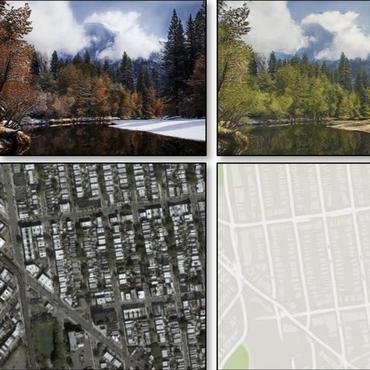Unsupervised Image-To-Image Translation
69 papers with code • 2 benchmarks • 2 datasets
Unsupervised image-to-image translation is the task of doing image-to-image translation without ground truth image-to-image pairings.
( Image credit: Unpaired Image-to-Image Translation using Cycle-Consistent Adversarial Networks )
Libraries
Use these libraries to find Unsupervised Image-To-Image Translation models and implementationsLatest papers with no code
Minimal Geometry-Distortion Constraint for Unsupervised Image-to-Image Translation
Unsupervised image-to-image (I2I) translation, which aims to learn a domain mapping function without paired data, is very challenging because the function is highly under-constrained.
Learning Energy-Based Generative Models via Coarse-to-Fine Expanding and Sampling
Energy-based models (EBMs) for generative modeling parametrize a single net and can be directly trained by maximum likelihood estimation.
GAIT: Gradient Adjusted Unsupervised Image-to-Image Translation
In this work, we propose an unsupervised IIT method that preserves the uniform regions after the translation.
Crossing-Domain Generative Adversarial Networks for Unsupervised Multi-Domain Image-to-Image Translation
In this work, we propose a general framework for unsupervised image-to-image translation across multiple domains, which can translate images from domain X to any a domain without requiring direct training between the two domains involved in image translation.
Improving Style-Content Disentanglement in Image-to-Image Translation
Unsupervised image-to-image translation methods have achieved tremendous success in recent years.
Image-to-image Mapping with Many Domains by Sparse Attribute Transfer
Unsupervised image-to-image translation consists of learning a pair of mappings between two domains without known pairwise correspondences between points.
Medical Image Generation using Generative Adversarial Networks
Generative adversarial networks (GANs) are unsupervised Deep Learning approach in the computer vision community which has gained significant attention from the last few years in identifying the internal structure of multimodal medical imaging data.
StereoGAN: Bridging Synthetic-to-Real Domain Gap by Joint Optimization of Domain Translation and Stereo Matching
Large-scale synthetic datasets are beneficial to stereo matching but usually introduce known domain bias.
On the Role of Receptive Field in Unsupervised Sim-to-Real Image Translation
Generative Adversarial Networks (GANs) are now widely used for photo-realistic image synthesis.
Unsupervised Many-to-Many Image-to-Image Translation Across Multiple Domains
To improve the image quality, we propose an effective many-to-many mapping framework for unsupervised multi-domain image-to-image translation.



 MNIST
MNIST
 Freiburg Forest
Freiburg Forest
